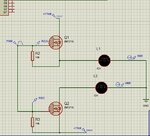NIDHINDAS
Newbie level 6

Hello,
PFA for the design using FAN-7392 to drive dual supply power with the dual load(battery) connected in series (+.........-+..........- ).
The microcontroller is PIC16F877A with separate Two PWM driving positive side and negative side MOSFET independently.
MCUs ground is -17 volt, not 0 of dual supply, to measure -ve volt as positive.
The issue is Q1 is not conducting now, what may be the reasons?
Q2 is working now.
2. MCUs can't measure -ve voltages how this is taken care of in the situation it needs.
Thanks in advance.
Regards,
Nidhindas
PFA for the design using FAN-7392 to drive dual supply power with the dual load(battery) connected in series (+.........-+..........- ).
The microcontroller is PIC16F877A with separate Two PWM driving positive side and negative side MOSFET independently.
MCUs ground is -17 volt, not 0 of dual supply, to measure -ve volt as positive.
The issue is Q1 is not conducting now, what may be the reasons?
Q2 is working now.
2. MCUs can't measure -ve voltages how this is taken care of in the situation it needs.
Thanks in advance.
Regards,
Nidhindas



